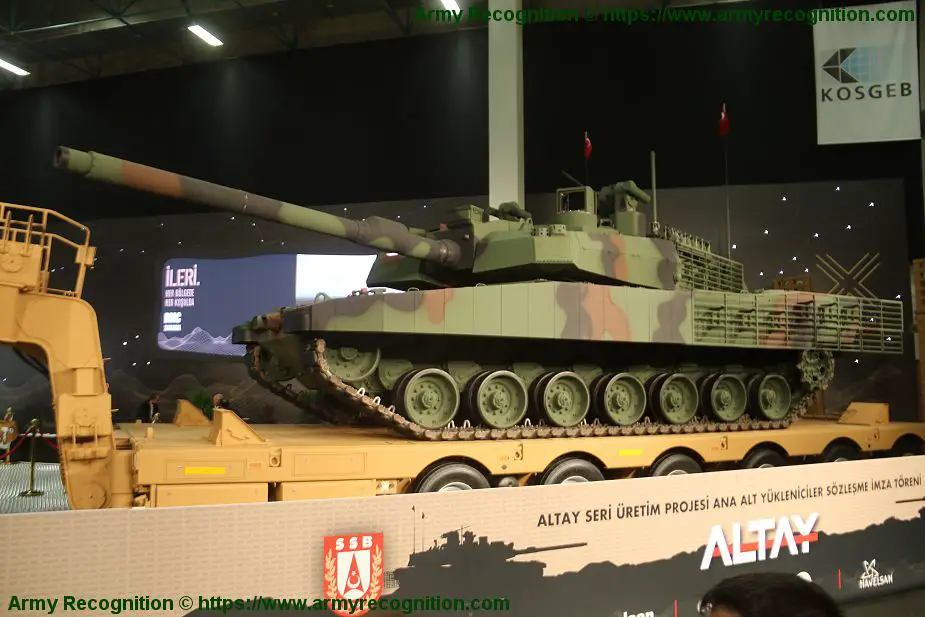Breaking news
Turkish armed forces to receive many new indigenous systems in 2020.
Several new land systems will be added to Turkey's defense forces' inventories in 2020. Crucial projects in the defense industry will continue in the new year, while several new vehicles and systems such as the newest armed drone Akinci and the upgraded version of the domestically developed T129 Tactical Reconnaissance and Attack Helicopter (ATAK) will enter the inventory of the Turkish army, the Presidency of Defense Industries (SSB) announced Monday.

Altay MBT (Picture source: Army Recognition)
Several aerial, naval and land systems will enter Turkish forces' inventory, İsmail Demir, the head of SSB, told a press conference in the capital Ankara.
Speaking at a yearly evaluation meeting, Demir said the HİSAR-A low-altitude air defense missile system, the first domestic maritime missile ATMACA and Turkey's largest-ever warship, the TCG Anadolu, are some of the indigenously produced systems to be added to the inventory of the Turkish military throughout the course of this year.
The HİSAR air defense missile system was developed by leading defense contractors Aselsan and Roketsan under the coordination of the SSB. HİSAR missiles are defense weapons developed to protect military bases, ports, facilities and troops against air-based threats as well as to meet the needs of the Turkish Armed Forces (TSK) for a low- and medium-altitude air defense security system. The HİSAR-O, medium-altitude air defense missile system, on the other hand, is expected to be in service by 2021.
Developed by the leading unmanned aerial vehicle developer Baykar, the UAV Akıncı with two turbine engines can carry nearly 1.5 tons in a useful load, 900 kilograms external and 450 kilograms internal. Flying at an operational altitude of 40,000 feet, the Akinci can stay in the air for 24 hours. The platform can be controlled via domestically developed satellites. The drone successfully completed its first test flight in December. The Akinci will also be equipped with an electronic support pod, air-to-air radars, a satellite communication system, barrier-identification radar, synthetic aperture radar and meteorological radar – all designed and developed in Turkey. The platform will operate with various ammunition configurations.
Among others, the TSK will start using next-generation land vehicles in 2020 such as the Kirpi-2 – a new version of a mine-resistant vehicle, mini-armored buses, armored ambulances and criminal investigation vehicles.
The first domestically produced 105mm Light Tracked Air Transportable Howitzer Fire Control System (BORAN) will also be delivered to Turkish forces, said Demir.
Demir said there are some technical drawbacks in the mass production of Turkey's first domestically made main battle tank Altay, adding that the search for alternatives regarding the engine and power packs is ongoing. "After we take care of these issues, we will launch an 18-month process to start mass production," Demir said. The tank will be manufactured by BMC, which produces various types of military vehicles, including tanks and armored cars, as well as commercial vehicles, buses and trucks.
Carrying out successful and custom-made projects to diminish the dependency on imported products and platforms, the Turkish defense industry has maintained its significant momentum in exports for the last couple of years.
As a result of expedited research and development activities and a range of products, the Turkish defense and aerospace industry carried its export performance to the top in 2019. According to the data obtained from the Turkish Exporters Assembly (TİM), the sector's exports soared 34.6% and hit $2.7 billion last year from $2.03 billion in 2018 – the first time defense exports surpassed $2 billion. Defense sales abroad, which totaled $360.3 million, observed the best monthly performance last year.




























